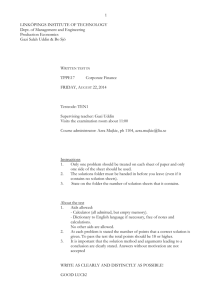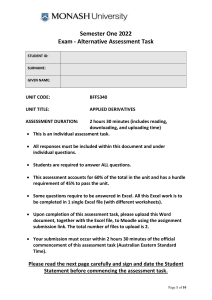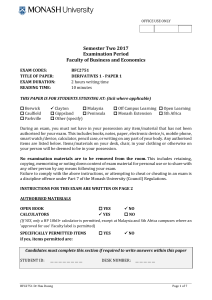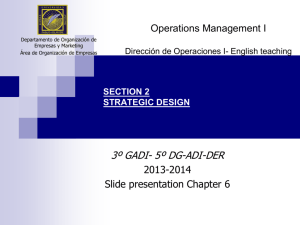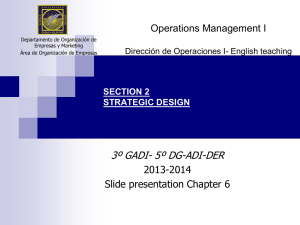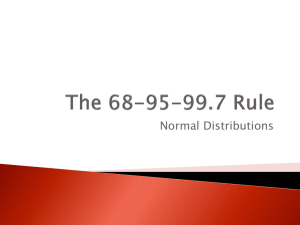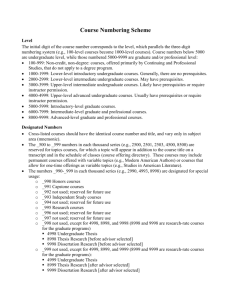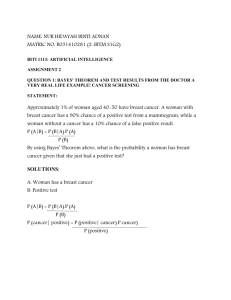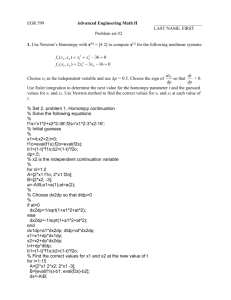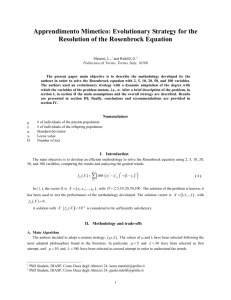TPPE17 Corporate Finance
advertisement
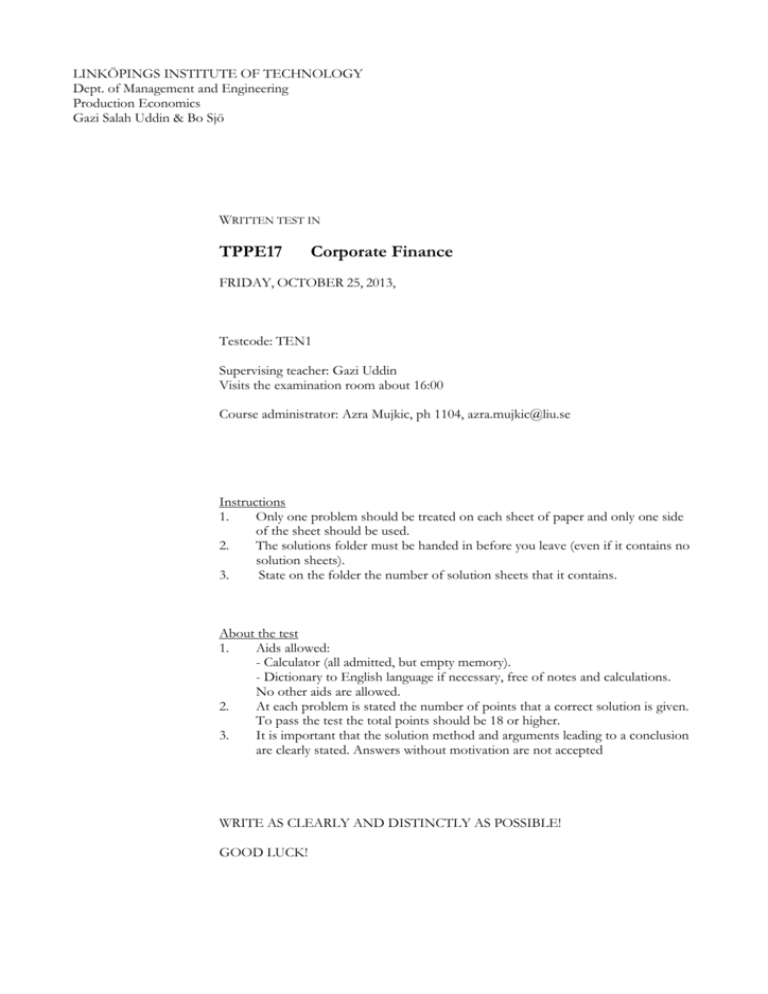
LINKÖPINGS INSTITUTE OF TECHNOLOGY Dept. of Management and Engineering Production Economics Gazi Salah Uddin & Bo Sjö WRITTEN TEST IN TPPE17 Corporate Finance FRIDAY, OCTOBER 25, 2013, Testcode: TEN1 Supervising teacher: Gazi Uddin Visits the examination room about 16:00 Course administrator: Azra Mujkic, ph 1104, azra.mujkic@liu.se Instructions 1. Only one problem should be treated on each sheet of paper and only one side of the sheet should be used. 2. The solutions folder must be handed in before you leave (even if it contains no solution sheets). 3. State on the folder the number of solution sheets that it contains. About the test 1. Aids allowed: - Calculator (all admitted, but empty memory). - Dictionary to English language if necessary, free of notes and calculations. No other aids are allowed. 2. At each problem is stated the number of points that a correct solution is given. To pass the test the total points should be 18 or higher. 3. It is important that the solution method and arguments leading to a conclusion are clearly stated. Answers without motivation are not accepted WRITE AS CLEARLY AND DISTINCTLY AS POSSIBLE! GOOD LUCK! Problem 1 (10 points) a) Explain the following concepts: i. The inherent conflict (dysfunctionality) of Corporate Governance in typical large public firm (1pts.) ii. The effect of market interest rates on Bond Prices and Yield (1pts.) b) Explain why maximizing the NPV is the correct decision rule in comparison to the IRR. (2pts.) c) Do you think a stable historical growth rate in dividends leads to a constant price of the firm’s stock? Explain. (2 pts.) d) Suppose that a young couple just had their first baby and they wish to insure that enough money will be available to pay for their child's college education. They decide to make deposits into an educational savings account on each of their daughter's birthdays, starting with her first birthday. Assume that the educational savings account will return a constant 7.5%. The parents deposit $2500 the first year and plan to increase the size of their deposits by 4.5% each year. What is the amount available for their daughter's college expenses on her 19th birthday, give that the parents made the final deposit on her 19th birthday? (2pts.) e) You have decided to refinance your mortgage. You plan to borrow whatever is outstanding on your current mortgage. The current monthly payment is $2500 and you have made every payment on time. The original term of the mortgage was 30 years, and the mortgage is exactly four years and eight months old. You have just made your monthly payment. The mortgage interest rate is 6.38% (APR). How much do you owe on the mortgage today? (2pts.) Problem 2 (10 points) a) Explain the following concepts: i. Systematic and unsystematic risk (1pts.) b) Write down the assumptions of the CAPM. Derive the CAPM mathematically. Explain the efficient portfolio and the capital market line. (Draw necessary diagrams and equations to justify of your answer) (1+2.5+1.5=5pts.) c) A hedge fund has created a portfolio using just two stocks. It has shorted $45,000,000 worth of Volvo stock and has purchased $75,000,000 of Toyota stock. The correlation between Volvo’s and Toyota’s returns is 0.65. The expected returns and standard deviations of the two stocks are given in the table below: Expected Return Standard Deviation Volvo 10% 40% Toyota 15% 45% i. What is the expected return of the hedge fund’s portfolio? ii. What is the standard deviation of the hedge fund’s portfolio? (1+1.5=2.5 pts.) d) The ABC Mutual Fund has an expected return of 25% and a volatility of 20%. ABC claims that no other portfolio offers a higher Sharpe ratio. Suppose this claim is true, and the risk-free interest rate is 4.5%. I. II. What is ABC’s Sharpe Ratio? If eBay’s stock has a volatility of 45% and an expected return of 15%, what must be its correlation with the ABC fund? (.5+1=1.5pts.) Problem 3 (10 points) a) Explain the following concepts: i. Direct and Indirect Bankruptcy costs (2 pts.) b) What are the assumptions underlying the Modigliani-Miller theorem? Mathematically derive the MM1 Proposition in the presence of corporate taxes and show that value of the levered firm is equal to the value of the unlevered firm plus present value of the tax shield. (1+2=3pts.) c) The valuation model of a growing firm seems to validate the theory of dividend policy irrelevance. Explain this model and show how it ignores dividend policy. Prove that dividend policy is irrelevant at a discount rate of 12 percent, if a firm with two million shares decides to trade-off dividend between two periods by paying 20 percent less in the current period as against the policy of constant $50m in all periods. (3 pts.) d) ABC maintains a debt-equity ratio of 0.85, and has an equity cost of capital of 12.5%, and a debt cost of capital of 7.5%. ABC’s corporate tax rate is 40%, and its market capitalization is $220 million. If ABC’s free cash flow is expected to be $10 million in one year, what constant expected future growth rate is consistent with the firm’s current market value? Estimate the value of ABC’s interest tax shield. (1+1= 2pts.) Problem 4 (10 points) a) Explain the following concepts: I. Clientele effect and the Signaling hypothesis? (1pts.) II. Risk neutral Probabilities (1pts.) III. Public and Private debt (1 pts.) IV. Convertible Bond and Warrant (1pts.)(=4 pts.) b) Write down the assumption of the Black-Scholes option pricing model. What is the unknown factor in valuation of options? Why would an investor be interested in creating a long strangle position? (1+2=3 pts.) c) Consider an option on TBX share with an exercise price (X) of $50.00 and maturing in 60 days. A call option is selling at a premium of $5.00 while a put option is selling at a premium of $3.00. The current market interest rate is 12% per annum while a TBX share is selling at $50.50 I. Estimate, with supporting explanations, the intrinsic and time values of the call and put options. II. III. Using the put-call parity relationship, explain if the options are appropriately priced. If the options are not appropriately priced explain how you are going to take advantage of the mispricing. Show and explain any profit position arising from your strategy in a diagram. (1+1+1 =3 pts.) TPPE17 Corporate Finance Exam 2013-10-225 5(5) THE CUMULATIVE NORMAL DISTRIBUTION Table gives N(x). To obtain N(-x) use N(-x) = 1-N(x). Use interpolation, e.g. N(0.6278) = N(0.62)+0.78*(N(0.63)-N(0.62))=0.7350 x 0,0 0,1 0,2 0,3 0,4 0,5 0,6 0,7 0,8 0,9 1,0 1,1 1,2 1,3 1,4 1,5 1,6 1,7 1,8 1,9 2,0 2,1 2,2 2,3 2,4 2,5 2,6 2,7 2,8 2,9 3,0 3,1 3,2 3,3 3,4 3,5 3,6 3,7 3,8 3,9 4,0 0 1 2 3 4 5 6 7 8 9 0,5000 0,5040 0,5080 0,5120 0,5160 0,5199 0,5239 0,5279 0,5319 0,5359 0,5398 0,5438 0,5478 0,5517 0,5557 0,5596 0,5636 0,5675 0,5714 0,5753 0,5793 0,5832 0,5871 0,5910 0,5948 0,5987 0,6026 0,6064 0,6103 0,6141 0,6179 0,6217 0,6255 0,6293 0,6331 0,6368 0,6406 0,6443 0,6480 0,6517 0,6554 0,6591 0,6628 0,6664 0,6700 0,6736 0,6772 0,6808 0,6844 0,6879 0,6915 0,6950 0,6985 0,7019 0,7054 0,7088 0,7123 0,7157 0,7190 0,7224 0,7257 0,7291 0,7324 0,7357 0,7389 0,7422 0,7454 0,7486 0,7517 0,7549 0,7580 0,7611 0,7642 0,7673 0,7704 0,7734 0,7764 0,7794 0,7823 0,7852 0,7881 0,7910 0,7939 0,7967 0,7995 0,8023 0,8051 0,8078 0,8106 0,8133 0,8159 0,8186 0,8212 0,8238 0,8264 0,8289 0,8315 0,8340 0,8365 0,8389 0,8413 0,8438 0,8461 0,8485 0,8508 0,8531 0,8554 0,8577 0,8599 0,8621 0,8643 0,8665 0,8686 0,8708 0,8729 0,8749 0,8770 0,8790 0,8810 0,8830 0,8849 0,8869 0,8888 0,8907 0,8925 0,8944 0,8962 0,8980 0,8997 0,9015 0,9032 0,9049 0,9066 0,9082 0,9099 0,9115 0,9131 0,9147 0,9162 0,9177 0,9192 0,9207 0,9222 0,9236 0,9251 0,9265 0,9279 0,9292 0,9306 0,9319 0,9332 0,9345 0,9357 0,9370 0,9382 0,9394 0,9406 0,9418 0,9429 0,9441 0,9452 0,9463 0,9474 0,9484 0,9495 0,9505 0,9515 0,9525 0,9535 0,9545 0,9554 0,9564 0,9573 0,9582 0,9591 0,9599 0,9608 0,9616 0,9625 0,9633 0,9641 0,9649 0,9656 0,9664 0,9671 0,9678 0,9686 0,9693 0,9699 0,9706 0,9713 0,9719 0,9726 0,9732 0,9738 0,9744 0,9750 0,9756 0,9761 0,9767 0,9772 0,9778 0,9783 0,9788 0,9793 0,9798 0,9803 0,9808 0,9812 0,9817 0,9821 0,9826 0,9830 0,9834 0,9838 0,9842 0,9846 0,9850 0,9854 0,9857 0,9861 0,9864 0,9868 0,9871 0,9875 0,9878 0,9881 0,9884 0,9887 0,9890 0,9893 0,9896 0,9898 0,9901 0,9904 0,9906 0,9909 0,9911 0,9913 0,9916 0,9918 0,9920 0,9922 0,9925 0,9927 0,9929 0,9931 0,9932 0,9934 0,9936 0,9938 0,9940 0,9941 0,9943 0,9945 0,9946 0,9948 0,9949 0,9951 0,9952 0,9953 0,9955 0,9956 0,9957 0,9959 0,9960 0,9961 0,9962 0,9963 0,9964 0,9965 0,9966 0,9967 0,9968 0,9969 0,9970 0,9971 0,9972 0,9973 0,9974 0,9974 0,9975 0,9976 0,9977 0,9977 0,9978 0,9979 0,9979 0,9980 0,9981 0,9981 0,9982 0,9982 0,9983 0,9984 0,9984 0,9985 0,9985 0,9986 0,9986 0,9987 0,9987 0,9987 0,9988 0,9988 0,9989 0,9989 0,9989 0,9990 0,9990 0,9990 0,9991 0,9991 0,9991 0,9992 0,9992 0,9992 0,9992 0,9993 0,9993 0,9993 0,9993 0,9994 0,9994 0,9994 0,9994 0,9994 0,9995 0,9995 0,9995 0,9995 0,9995 0,9995 0,9996 0,9996 0,9996 0,9996 0,9996 0,9996 0,9997 0,9997 0,9997 0,9997 0,9997 0,9997 0,9997 0,9997 0,9997 0,9997 0,9998 0,9998 0,9998 0,9998 0,9998 0,9998 0,9998 0,9998 0,9998 0,9998 0,9998 0,9998 0,9998 0,9999 0,9999 0,9999 0,9999 0,9999 0,9999 0,9999 0,9999 0,9999 0,9999 0,9999 0,9999 0,9999 0,9999 0,9999 0,9999 0,9999 0,9999 0,9999 0,9999 0,9999 0,9999 0,9999 0,9999 0,9999 0,9999 0,9999 0,9999 1,0000 1,0000 1,0000 1,0000 1,0000 1,0000 1,0000 1,0000 1,0000 1,0000 1,0000 1,0000 1,0000 1,0000 1,0000 1,0000 1,0000 1,0000 1,0000 1,0000 TPPE17 Corporate Finance Exam 2013-10-225 6(5)
